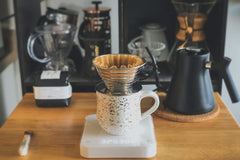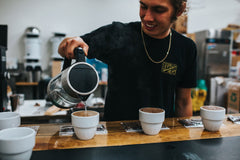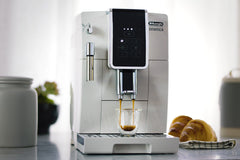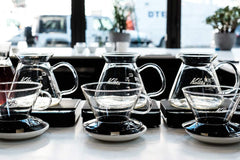
For the more experienced coffee drinker, grinding isn’t a one size fits all step of the brewing process.
If you’re browsing the coffee aisle of your grocery store, you know the pre-ground (and stale) bags of coffee all too well. Not only does this cause your coffee to spoil faster, but you can end up with a less-than-quality brew when paired with the wrong grind.
Worried about buying whole bean?
Don’t be!
Many coffee houses will grind a bag of whole beans for you at any grind size if you ask, and some supermarkets have specific coffee brands you can grind in store.
If you want the freshest coffee though, you should grind it right before you brew it with freshly roasted beans.
Don’t be intimidated by personal grinders and wondering which grind goes with what method – we’ve got you covered.
Sip on Espressos with Fine Grinds
When you indulge in an espresso or true-to-form macchiato, you likely see the barista tamping the grounds in the espresso filter before brewing.
Tamping is essential because it allows the barista to press loose grounds into a puck of coffee that makes it harder for the water to pass, which will require more pressure to brew – good pressure means good espresso!
To get the coffee in tight means that the coffee needs to be a fine grind. A course grind won’t hold its form as a fine grind can, and once the water hits a course grind in an espresso machine, you’re begging for a mess and busted machine.
Fine ground coffee also works well with stovetop espresso makers! A similar concept, just friendlier for the at home espresso lover.
The pressure allows for a good strong cup, while a fine grind in, say a pour over, would take too long or not steep properly.
>> Learn how to make a great espresso at home
Mellow Out with a Medium Pour Over Grind
Medium grinds are far from the middle ground of coffee!
Once you get above fine grinds, we start to look at brew methods that require less pressure. With the lower pressure, it helps to have a larger grind so that the coffee doesn’t steep too long or be unable to pass through while filtering.
Most pour-over and flat-bottomed brewers will use this medium grind but try to keep it on the finer side if possible.
If you’re unsure what kind of grind to use with your specific pour-over brewer – play it safe with a tried and true medium grind.
The only pour-over method that requires a coarser medium grind is the Chemex. Considering the Chemex design and filter, a medium-coarse grind gives you the best-tasting coffee with the best brew time.
If you go more medium to medium-fine, the brew time will be thrown off, and the coffee won’t have its best flavor.
>> Discover our top picks for the best pour over coffee maker
Relax with Bold, Coarse Grinds
Coarse grinds are best suited for your brew methods like a French Press.
French Presses require that coarse grind so that the beans can free flow while it's brewing, and it makes it easier to filter in the pot itself. If you had a fine grind in a French press, you’d end up with silty, bean-filled coffee – a coffee experience nobody wants.
You can get away with a coarse grind in other pressure-free brewing methods like the Chemex, but be aware that the coffee won’t have the best steeping and brewing times, so the flavor will be lighter.
>> Discover our top picks for the best French Press
What about AeroPress Coffee Grind?
You might be wondering why the AeroPress hasn’t made it on this list yet.
AeroPress is unique in that you can use anything from a medium-fine to coarse grind coffee in an AeroPress and have great coffee – as long as you know how long to steep it.
There is a sweet spot with AeroPress in the medium grind area, but if you’re in a pinch and only have a coarse grind available, you can still enjoy a good brew.
Getting Back to Basics – The Bean
When you boil it down (pun unintended), the grind is an important step in brewing, but it all starts with a quality coffee bean.
Coffee that’s been sitting on the shelf of your grocery store for a few months is stale and won’t have the same taste as a freshly roasted coffee bean.
That’s where we come in.
We not only source some of the finest small-batch coffee beans in the world, we freshly roast the beans to perfection bringing out each bean's unique flavor notes.
Best of all?
With a monthly coffee subscription from Nomad Coffee Club, a freshly roasted bag of beans will arrive on your doorstep each month.
Start your nomadic coffee journey around the world today!






